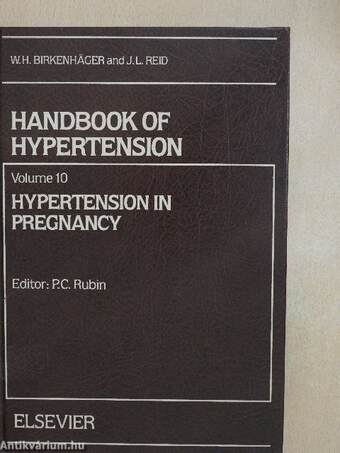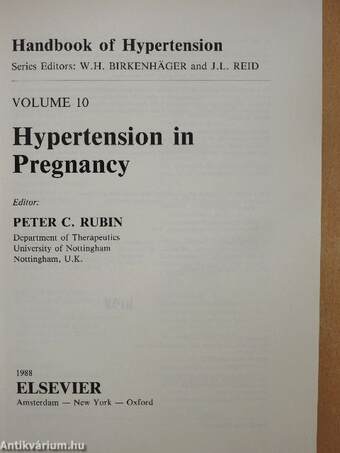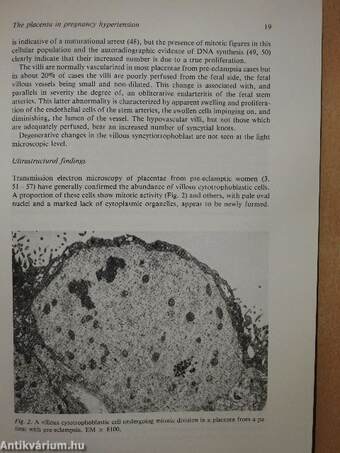1.067.317
kiadvánnyal nyújtjuk Magyarország legnagyobb antikvár könyv-kínálatát

VISSZA
A TETEJÉRE
JAVASLATOKÉszre-
vételek
Hypertension in Pregnancy
| Kiadó: | Elsevier |
|---|---|
| Kiadás helye: | Amsterdam-New York |
| Kiadás éve: | |
| Kötés típusa: | Fűzött keménykötés |
| Oldalszám: | 387 oldal |
| Sorozatcím: | Handbook of Hypertension |
| Kötetszám: | 10 |
| Nyelv: | Angol |
| Méret: | 25 cm x 17 cm |
| ISBN: | 0-444-90470-0 |
| Megjegyzés: | Fekete-fehér fotókkal, ábrákkal. További szerzők a könyvben. |
naponta értesítjük a beérkező friss
kiadványokról
naponta értesítjük a beérkező friss
kiadványokról
Előszó
Foreword
The concept of the Handbook of Hypertension developed in the late 1970s from a widespread feeling that the diversity of interests and inputs into hypertension research did not lend... Tovább
Előszó
Foreword
The concept of the Handbook of Hypertension developed in the late 1970s from a widespread feeling that the diversity of interests and inputs into hypertension research did not lend themselves to publication in a single textbook. The Handbook of Hypertension has now come of age and is recognized as an authoritative source of information and reviews on clinical and research aspects of high blood pressure.
The scope of hypertension in man has developed over the last 30 years from the short-term care of a small number of hospitalized patients with severely elevated blood pressure and extensive target-organ failure to a major long-term community-health problem involving a substantial proportion of the population. It appeared possible at one time that the mechanisms involved in the pathogenesis of hypertension could be identified by a limited number of circumscript and straightforward experiments in laboratory animals. This is clearly not so. The field of experimental hypertension has, if anything, expanded even more than clinical practice.
We shared with our Publishers the view that the accumulation of biological and chnical knowledge in the field of hypertension had outgrown the limhations of the classical monograph. Moreover, the subject of hypertension by its very nature is a muhidisciplinary one, attracting such diverse professionals as biochemists and pubhc health workers, in addition to clinicians. When one tries to envisage what would happen to a single all-encompassing book, it is clear that it could never satisfy the different groups involved in high blood pressure. Some sections would become outdated rapidly while others would have a longer life-span. An alternative, to escape from the constraints of a single textbook and to reconcile the interests of both generalists and specialists, was to choose the format of a serial handbook.
The series as it stands has resulted from lengthy discussions with chnicians and scientists. We believe that it will be of interest to many different groups including clinical investigators, house officers, general practitioners, pharmacologists, pharmacists, biological scientists, physiologists and epidemiologists.
The present volume addresses the intriguing topic of hypertension in pregnancy. It aims to bridge the existing conceptual gap between obstetricians and internists.
Listed below are the titles of further volumes currently in preparation as well as revised or updated editions of earher volumes.
Clinical Pharmacology of Antihypertensive Drugs - revised and updated (Editor: A.E. Doyle)
Hypertension in the Elderly (Editors: A. Amery and J. Staessen) Management of the Hypertensive Patient (Editors: F.R. Biihler and J.H. Laragh) Clinical Aspects of Hypertension - revised and updated (Editor: J.LS. Robertson)
Further subjects under consideration are: Techniques of Measuring Blood Pressure; History of Hypertension Research; Update on Epidemiology.
Each volume is intended to be complete and separate in its own right, and not dependent on other volumes in the series. We have accepted some degree of overlap Vissza
Tartalom
Contents
Foreword ix
W.H. Birkenhäger and J.L. Reid
Preface xi
E.M. Symonds
Introduction xiii
P.C. Rubin
1. The physiology of normal pregnancy 1
M. de Swiet
2. Hypertension in pregnancy: clinical features 10
P.C. Rubin
3. The placenta in pregnancy hypertension 16
H. Fox
4. Renal hemodynamics and intravascular volume in normal and hypertensive pregnancy 38
L.C. Chesley and M.D. Lindheimer
5. Hemodynamics in hypertensive pregnancy 66
H.C.S. Wallenburg
6. Prostanoids in normal and hypertensive pregnancy 102
T.F. Ferris
7. The renin - angiotensin system in normal and hypertensive pregnancies 118 F. Broughton Pipkin
8. Autonomic nervous system and vascular reactivity in normal and hypertensive pregnancy 152
E.B. Pedersen
9. Animal models of pre-eclampsia 168
A.F. Phippard and J.S. Horváth
10. A review of clinical trials in pregnancy hypertension 186
A.E. Fletcher and C.J. Bulpitt
11. Chronic and secondary hypertension 202
E. Gallery
12. The epidemiology of hypertension during pregnancy 223
D.J. Taylor
Contents XXXIX
13. Clotting alterations associated with the pre-eclampsia/eclampsia syndrome 241
C.P. Weiner
14. The immunologic concept of pre-eclampsia 257
A. El-Roeiy and N. Gleicher
15. Pregnancy-induced hypertension and pre-eclampsia: the fetus and the
neonate 267
M.L. Druzin
16. Management of pregnancy-induced hypertension 290
F.G. Cunningham and K.J. Leveno
17. Eclampsia 320
B.M. Sibai
18. The children of women who had hypertension during pregnancy 341
M. Ounsted
Index 363 - 387
Témakörök
- Orvostudomány > Kórélettan
- Idegennyelv > Idegennyelvű könyvek > Angol > Orvostudomány
- Orvostudomány > Általános orvosi, egyéb > Idegennyelvű
- Orvostudomány > Általános orvosi, egyéb > Kutatások, kísérletek
- Orvostudomány > Belgyógyászat > Általános > Idegennyelvű
- Orvostudomány > Belgyógyászat > Általános > Terápia
- Orvostudomány > Belgyógyászat > Általános > Betegségek > Szív- és érrendszeri
- Orvostudomány > Orvosi idegennyelvű könyvek > Általános orvosi
- Orvostudomány > Orvosi idegennyelvű könyvek > Belgyógyászat
- Orvostudomány > Orvosi idegennyelvű könyvek > Kórélettan










